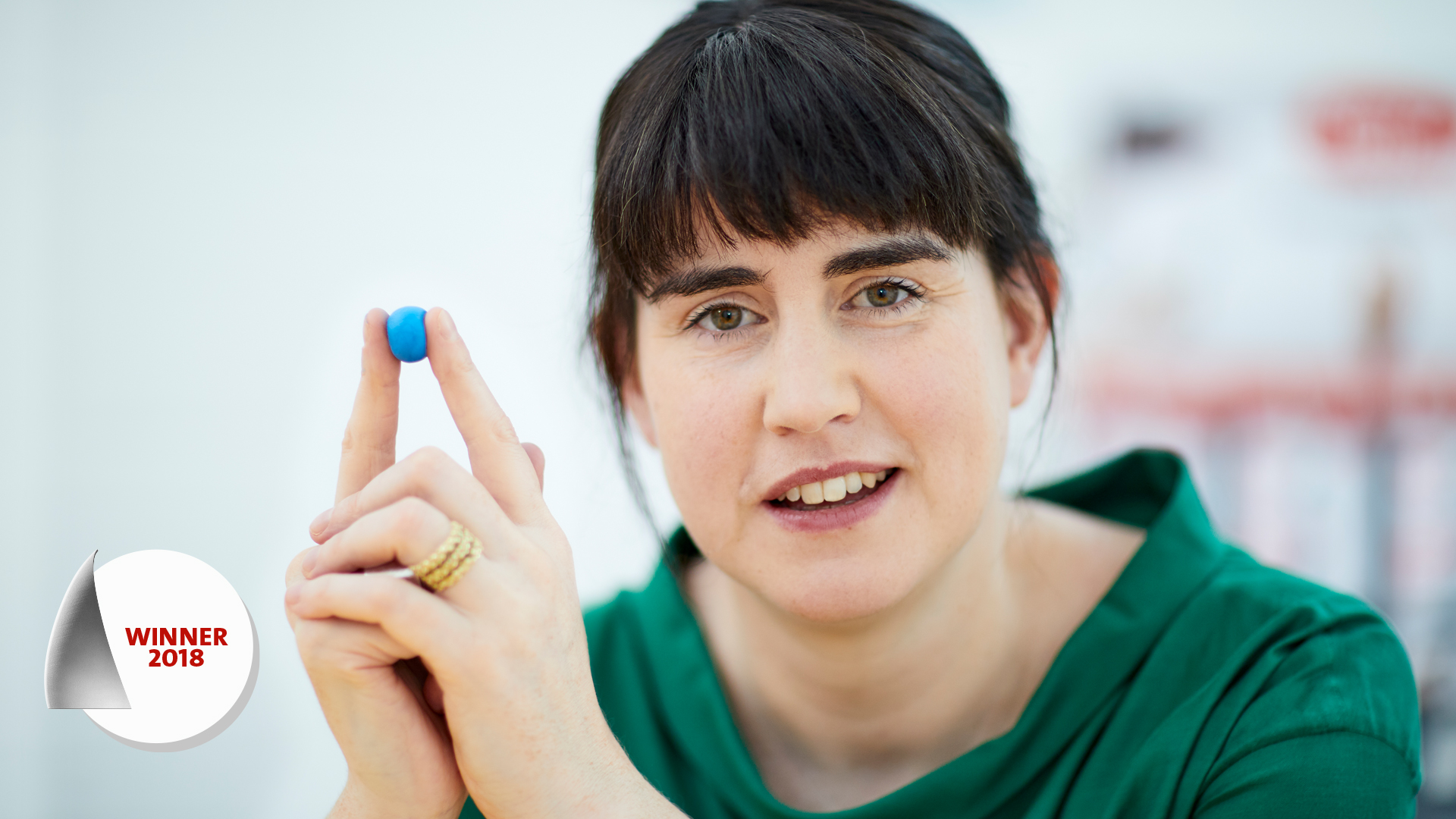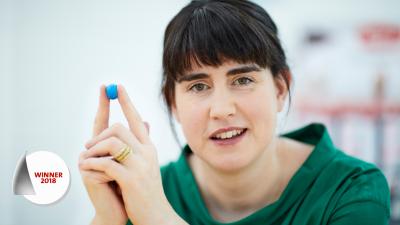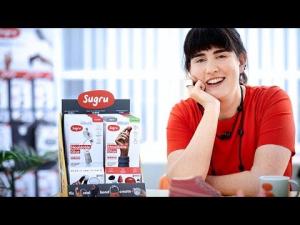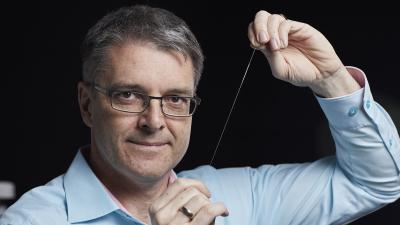Jane ní Dhulchaointigh and team
Sugru: multi-purpose mouldable glue
Winner of the European Inventor Award 2018
The game-changing invention of Irish product designer Jane ní Dhulchaointigh and her team is designed to help unleash our creativity and change the world we live in. Called Sugru, it is the world's first mouldable glue and enables users to fix, improve and customise the things they own, thereby taking a more thoughtful and sustainable approach to their possessions.
Adhesive tapes and glues can repair damaged everyday items such as cracked coffee mugs and worn computer cables, but such fixes are frequently neither durable nor practical, especially if a part is missing.
Sugru - which takes its name from the Irish word for "play" - is easy to use, versatile and can be moulded to form "missing parts". It is extremely adhesive and durable without becoming brittle. Once set, it is slightly flexible (like hard rubber) and can bear weights of up to two kilogrammes.
Societal benefit
Ní Dhulchaointigh says that it was in 2003, while she was studying for her master's degree in Product Design at the Royal College of Art (RCA) in London, that she hit on her idea for a product that would enable people to affordably repair the things they were not otherwise able to fix.
The United Nations University predicts that 50 million metric tonnes of e-waste will be generated globally in 2018 - including 9.3 million metric tonnes of discarded personal digital devices such as computers, screens, smartphones, tablets and TVs. Naturally, a product like Sugru can play an important role in reducing such waste by providing people with the opportunity to repair and improve their possessions, rather than discarding and replacing them.
Sugru is fun to work, play and experiment with. An online community of enthusiasts from around the world regularly shares its exploits with the product, from school children who sent a camera into space using Sugru to a North Pole explorer who personalised his ski poles with it. The company claims its community has used the product in 175 countries to fix over 15 million things.
"I guess that I had a very clear idea, a simple vision for what Sugru could become and there's a real kind of sense of purpose behind it," ní Dhulchaointigh explains. "It wasn't just an idea for a product and maybe somebody will like it. I actually believed that there's the potential to change the world here."
Economic benefit
Ní Dhulchaointigh teamed up with now husband James Carrigan and UK entrepreneur Roger Ashby, with whom she founded the company FormFormForm Ltd in 2004 while still studying. She also enlisted the efforts of a pair of retired silicone scientists. Together, ní Dhulchaointigh and team spent 8 000 hours in the lab and received EUR 540 000 in private funding to develop the product.
As they worked towards the product launch in 2009, ní Dhulchaointigh hired FormFormForm's first full-time employee, materials scientist Tom Dowden - now the company's principal researcher. She also consulted with a 150-strong user community that provided her with feedback on how to improve Sugru. Backed by a strong social media campaign and a handful of five-star media and blogger reviews, the first 1 000 packets of Sugru sold out in six hours. Sales rocketed thereafter, reaching EUR 4 million in 2015.
Sugru's popularity, combined with ní Dhulchaointigh's clever use of social media and customer inclusion to develop the product, has helped crowdfund a nearly EUR 6-million investment in FormFormForm since 2015.
The company now employs over 60 people in London and boasts 2.5 million users of Sugru. The product is sold online and in more than 6 000 shops worldwide.
Given Sugru's uniqueness - it is one of only two mouldable glues currently on the market - it does not easily fall into a product category. The market for adhesives and sealants, to which it might best be assigned, is forecast to grow globally from EUR 43 billion in 2016 to almost EUR 55 billion by 2021, according to MarketsandMarkets.
FormFormForm recently launched a new, "family-safe, skin-friendly" version of Sugru, which children as young as eight can safely use without supervision.
How it works
Having previously studied sculpture, ní Dhulchaointigh began to play with the idea of creating something that could be used to "fix and improve and reimagine the stuff I already have" while studying for her master's degree at RCA. Experimenting with household sealants and other materials such as wood-dust powder, she eventually hit on her idea for a mouldable glue.
Once removed from its packaging, Sugru - which is available in a variety of colours - remains mouldable for about 30 minutes and then requires approximately 24 hours to cure to a rubbery finish.
Strong, flexible and waterproof, Sugru has a service temperature range between -50°C and +180°C. It adheres to most materials, including metal, glass, fabric and ceramics. And it can be easily removed from most surfaces using a sharp blade.
Sugru itself is not biodegradable, as the durability of its materials is important, particularly when used to repair outdoor objects or performance items such as skis or scooters. The company, however, has a programme of continuous improvement for its packaging and its environmental footprint in general, and has moved from plastic packaging to paper-based packaging and ethically sourced paper-based materials. Moreover, because repairs made with Sugru enable far more sustainable behaviours, the net impact of the product is positive.
The inventor
Born in Kilkenny, Ireland, ní Dhulchaointigh's early inspiration for fixing and customising things was nurtured by growing up on a farm where replacing everyday items was not easy. That inspiration grew as she progressed through her studies in sculpture and product design, manifesting itself in the creation of a truly ground-breaking product. And although the product seems deceptively simple - fanciful even - it has serious origins, as ní Dhulchaointigh explains: "It took a lot of hard work and the thing that keeps us going is that it is making a difference to people's lives and we can see that from every email and story from our users thanking us for what it has enabled them to do."
Accolades soon flowed. In 2010, TIME magazine placed Sugru 22nd on its list of "50 Best Inventions of the Year". In comparison, the iPad came 34th that year.
Did you know?
A business on a mission, ní Dhulchaointigh and her team perceive themselves as part of a global repair movement that is about addressing environmental challenges by repairing all sorts of household appliances and devices. Although it is a very creative business, she sees it more as a means to an end. "It's not about making money," says ní Dhulchaointigh. "We are here to change the world and enable everyone's creativity and that means being creative ourselves, whether that is about how we get the word out or how we make our product easier to use and more appealing."
Media gallery
Patent numbers:
Contact
European Inventor Award and Young Inventors Prize queries:
european-inventor@epo.org Subscribe to the European Inventor Award newsletterMedia-related queries:
Contact our Press team#InventorAward #YoungInventors











